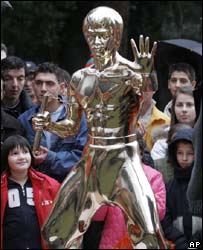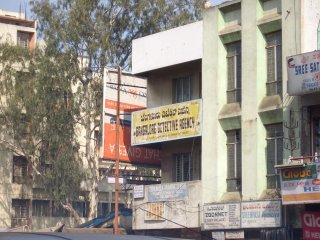She's Baaack (from India)Actually, I've been back for a few days, but very busy and just a little sick still. (I'll write about air pollution and
The Challenge of the 21st Century later, but let us say that it's a topic very much on my mind even as it slowly fades from my lungs and sinuses.)
Vignette: I spent a morning in a monastery, waiting for a ceremony to be completed in an inner sanctum. A monk very busily circled through the room, out one door, and around, behind it, on the veranda and its kitchen, and back again through another door, checking up on all the vegetables being cut and pots being washed and work being done, too busy to sit down as he munched on his breakfast of puffed rice and salad. A young man lay on a sleeping pad on the floor, his eyes closed. A little girl in a skirt sat on a pile of cushions near him, long hair in her face, armed with a knife and a cucumber, ponderously taking off thin slices and dropping them upon his lids. When did this monastery, so dear to my family, start dabbling in matters of the spa? The puffed-rice eating monk paces around on his dutiful rounds to check the cucumbers-on-the-eyes. "Feel better?" "Yes!" "Good! Just lie there! You! Change the slice!" Another man, quite elderly, comes in and laughingly accuses the girl of playing a trick on the supine youth by throwing cucumber on his sleeping face, to which she angrily responds by explaining that it's medicine and the shush-eyed one is not asleep. The elderly man does not believe her, and he then so carefully slips the green rounds off the "sleeping" youth that the youth does not stir. Around again comes the monk, finishing his breakfast, barely able to put the plate down and wash his mouth before he notices the lack of salady eyes and asks the girl why she decuked the youth. She makes the universal pout of "wasn't me!" and points at the dubious elder, who is still laughing at her silliness. The busy monk gives what I can only describe as a very, very modulated roar. "It's medicine!" and then he lets out a small scolding, light and hard and quick, like a boxing teacher to a child. The elderly man sees the folly of his way, the girl gherkins up the burning eyes, and the pacing monk picks up work and has finished three jobs before he makes it around the other side."Everywhere it is like this," my mother whispers to me, and I am baffled until she continues. "One person does the work of twenty."
I'm not sure what it was about this scene--the morning light streaming through the bars of the glassless windows, the scent of sliced cucumber, the busyness of the leader who always ends up carrying much of the yoke--but it has rather stuck with me. I have not really mused out its lesson, still just observing.
One lesson, always relearned harder, is to not carry what you don't need to carry. On the Air India flight back, one elderly Sikh gentlemen demonstrated this principle with a new panache. Well, he had to have his elegant rose-tinged white turban, wrapped straight around his head, no
lissajous twisted twirling. And he had to have his foot long white two-pointed, effortlessly curled beard. The
heavy bangle, of course, was not going to be checked in. One needs a shirt to be allowed on a plane, and he had quite a shirt---an elegant knee length tunic, slightly off-white, perhaps a tussar silk and cotton blend, so shiny and smooth. Similarly one needs shoes, and everyone knows shoes work best with socks---elegant khaki argyles, pulled all the way up to the knee.
And with all that, really--even if the kurta-tunic has side slits that go up past the knees---with all that, a man
does not need pants.
Thanks to my guest bloggers for doing such a wonderful job. I have some further plans for sharing their musings with you, but for now, I'll give them a big round of applause.
 Too Cool For School
Too Cool For School















